Pam Binder's Blog, page 3
November 3, 2017
When Plots Fail
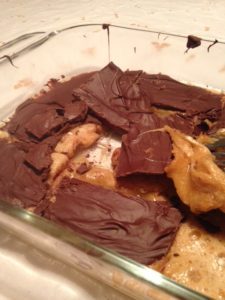
Chocolate Sponge Candy – When Plots Fail
This picture doesn’t tell the whole story. If you look at it at the different angles, the glob of caramel and chocolate might look tasty. News flash – it’s not. The candy tastes like a cross between sticky taffy, and playdough. It is an embarrassing fact that I know what playdough tastes like.
In retrospect, I know what I did wrong. First, was choosing this recipe in the first place. Even in the picture from the cook book, I had my doubts, but it looked good, so I thought – what the heck. The second thing was thinking I could “wing it” and not use a candy thermometer. You can guess the rest. I stopped cooking it too soon and used the wrong size pan. What I learned was that this recipe was a lot like plots. Sometimes the plot looks good on the surface, but that doesn’t mean it will work.
I was caught up with the image, instead of looking at the plot from every angle. Was it right for the characters? Did it move the story forward? How did it fit with the other plots? Did they weave together easily, or id I have to force it?
Every time you try to force a plot into submission, think of this vision of Chocolate Sponge Candy. For those who are adventurous, I’ve included the recipe below. 
November 2, 2017
When Plots Fail
Chocolate Sponge Candy – When Plots Fail
This picture doesn’t tell the whole story. If you look at it at the different angles, the glob of caramel and chocolate might look tasty. News flash – it’s not. The candy tastes like a cross between sticky taffy, and playdough. It is an embarrassing fact that I know what playdough tastes like.
In retrospect, I know what I did wrong. First, was choosing this recipe in the first place. Even in the picture from the cook book, I had my doubts, but it looked good, so I thought – what the heck. The second thing was thinking I could “wing it” and not use a candy thermometer. You can guess the rest. I stopped cooking it too soon and used the wrong size pan. What I learned was that this recipe was a lot like plots. Sometimes the plot looks good on the surface, but that doesn’t mean it will work.
I was caught up with the image, instead of looking at the plot from every angle. Was it right for the characters? Did it move the story forward? How did it fit with the other plots? Did they weave together easily, or id I have to force it?
Every time you try to force a plot into submission, think of this vision of Chocolate Sponge Candy. For those who are adventurous, I’ve included the recipe below. 
October 30, 2017
Chocolate and the Craft of Writing: Preparation and Planning
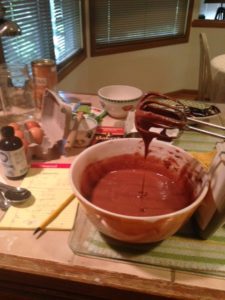
Whether you make dessert or write a story — preparation is critical.
The beginning of a story starts with the question; What if? For example, the idea for my series, The Matchmaker Café, came to me while my husband and I were traveling in Scotland. We were both taking pictures and I was narrowing my focus to doors; castle doors, cottage doors, pub doors and so on. At the top of many of the doors was engraved or painted, the word, ‘Established’ and next to it the year. I remembered that this was not that uncommon throughout Europe.
That’s when it hit me. What if when you opened the door, crossed over the threshold and were transported to the date the door was installed? Since I love writing time travels, this idea offered limitless possibilities. I couldn’t wait to get started. Opening a door to the past is the premise of the Matchmaker Café series, and I’m excited to announce that Falling in Love with Emma, is book three in the series, and will be released on October 27, 2017. But as you can see from this cooking preparation photo, just knowing the basic plot, doesn’t guarantee the writing process will be smooth sailing, any more than following a friend’s recipe will result in a culinary masterpiece. That’s where preparation comes in.
A recipe might contain, eggs, sugar flour, baking powder, butter, chocolate, and vanilla, in the same way as a story contains, characters, setting, plot, point of view, conflict, emotion, and romance. The magic in whether our cake, or story, is a success, is in how we put these ingredients together.
If you forget to add the vanilla, your cake will be bland. If you forget to add emotion, your characters will be lifeless. As writers we know our characters, but I don’t rely on instincts that everything will all work out, I rely on a rewriting and check lists. At the top of each scene I have a check list that reminds me to rewrite the scene until it breathes with life and emotion. This list contains the following; emotion at opening of scene, emotion at end of scene, point of view character, setting, plot, hook, and secret.
Falling in Love with Emma was fun to write because, not only were Emma and Björn struggling to take their relationship from the friend zone, to the romance zone, but my heroine owned a French bakery and my hero owned a fish market. Emma followed recipe directions, and Björn believed the secret to a great meal was to barbeque. As a result, I used food (chocolate to be specific) to explore the ebb and flow of Emma and Björn’s relationship.
Please check out book three in the Matchmaker Café series, Falling in Love with Emma available on Amazon http://a.co/6KjM6Lp
October 29, 2017
Chocolate and the Craft of Writing: Preparation and Planning
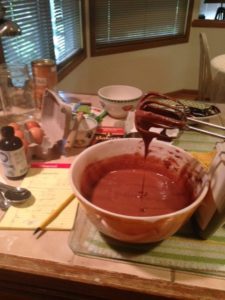
Whether you make dessert or write a story — preparation is critical.
The beginning of a story starts with the question; What if? For example, the idea for my series, The Matchmaker Café, came to me while my husband and I were traveling in Scotland. We were both taking pictures and I was narrowing my focus to doors; castle doors, cottage doors, pub doors and so on. At the top of many of the doors was engraved or painted, the word, ‘Established’ and next to it the year. I remembered that this was not that uncommon throughout Europe.
That’s when it hit me. What if when you opened the door, crossed over the threshold and were transported to the date the door was installed? Since I love writing time travels, this idea offered limitless possibilities. I couldn’t wait to get started. Opening a door to the past is the premise of the Matchmaker Café series, and I’m excited to announce that Falling in Love with Emma, is book three in the series, and will be released on October 27, 2017. But as you can see from this cooking preparation photo, just knowing the basic plot, doesn’t guarantee the writing process will be smooth sailing, any more than following a friend’s recipe will result in a culinary masterpiece. That’s where preparation comes in.
A recipe might contain, eggs, sugar flour, baking powder, butter, chocolate, and vanilla, in the same way as a story contains, characters, setting, plot, point of view, conflict, emotion, and romance. The magic in whether our cake, or story, is a success, is in how we put these ingredients together.
If you forget to add the vanilla, your cake will be bland. If you forget to add emotion, your characters will be lifeless. As writers we know our characters, but I don’t rely on instincts that everything will all work out, I rely on a rewriting and check lists. At the top of each scene I have a check list that reminds me to rewrite the scene until it breathes with life and emotion. This list contains the following; emotion at opening of scene, emotion at end of scene, point of view character, setting, plot, hook, and secret.
Falling in Love with Emma was fun to write because, not only were Emma and Björn struggling to take their relationship from the friend zone, to the romance zone, but my heroine owned a French bakery and my hero owned a fish market. Emma followed recipe directions, and Björn believed the secret to a great meal was to barbeque. As a result, I used food (chocolate to be specific) to explore the ebb and flow of Emma and Björn’s relationship.
Please check out book three in the Matchmaker Café series, Falling in Love with Emma available on Amazon http://a.co/6KjM6Lp
Chocolate and the Craft of Writing – Drinking Chocolate and Setting
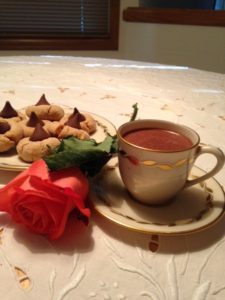
When I first started writing, Falling in Love with Emma, I’m sure it was a “dark and stormy night,” because I thought about the French-style of drinking chocolate…a lot. Spoiler alert. It’s a typical fall day in Seattle, and I’ve just brewed a warm cup of drinking chocolate. Yum! Anyway, back to the blog.
In my story, I transported Emma and Bjorn back in time to 18th century Paris, on the eve of the French Revolution, where chocolate houses were almost as abundant as coffee cafés are in Seattle today. For those who have read my books, they know that somewhere in the story, someone will mention their love of chocolate. But Falling in Love with Emma took on a whole new level. Although I knew the time and place, I wanted my readers to experience the atmosphere, or setting.
Your setting is as important as your characters. After all, the setting affects how the characters react and move through the story. To see this in action all you have to do is watch a disaster movie. Without the fire, wind or snow storm, the story wouldn’t be the same. Setting can enhance a character’s mood, or bring them down. Setting can also help a character achieve their goal, or stand in the way.
As I mentioned, the idea of setting as a character is never more apparent than in a disaster movie, involving fire, wind, or rain. There is a movie, Backdraft, with fire fighter, Kurt Russell, where he and his brother refer to fire as though it were a living, breathing, entity, unpredictable and capable of seeking revenge. This makes fighting fires feel even more dangerous.
On the lighter side, the movie Chocolate, with Johnny Depp, not only makes the symbol of chocolate a main character, but this confection, changes in appearance and brings people together. Check out this movie and see for yourself.
When you describe a setting, you must always ask this question. How does it move the story forward? If you describe the wind or rain, it can’t be just because it sounds cool, there has to be a reason why it’s raining. How does your character respond to rain? Will her response help or hinder her as she tries to move forward?
If you have ever tasted the French-style of drinking chocolate it is an event. It is so rich and so thick that you are tempted to use a spoon. Drinking chocolate reminds me of setting because when you layer setting into your story, it is the opportunity for your character (and thus your reader) to slow down and savor the moment.
I have listed the recipe for drinking chocolate below and please check out book three in the Matchmaker Café series, Falling in Love with Emma and let me know what you think.
French-style Drinking Chocolate
2 cups whole milk (cream is really the best)
5 ounces or more of dark chocolate, chopped.
Optional – light brown sugar or honey
Optional – dash of chili powder as was mentioned in the movie Chocolate
Heat the milk or cream in a sauce pan. Once it is warm, whisk in the chocolate, stirring until melted and steaming hot. Taste, and add brown sugar, honey or chili. You can add a whipped cream if you like.
October 28, 2017
Chocolate and the Craft of Writing – Drinking Chocolate and Setting
When I first started writing, Falling in Love with Emma, I’m sure it was a “dark and stormy night,” because I thought about the French-style of drinking chocolate…a lot. Spoiler alert. It’s a typical fall day in Seattle, and I’ve just brewed a warm cup of drinking chocolate. Yum! Anyway, back to the blog.
In my story, I transported Emma and Bjorn back in time to 18th century Paris, on the eve of the French Revolution, where chocolate houses were almost as abundant as coffee cafés are in Seattle today. For those who have read my books, they know that somewhere in the story, someone will mention their love of chocolate. But Falling in Love with Emma took on a whole new level. Although I knew the time and place, I wanted my readers to experience the atmosphere, or setting.
Your setting is as important as your characters. After all, the setting affects how the characters react and move through the story. To see this in action all you have to do is watch a disaster movie. Without the fire, wind or snow storm, the story wouldn’t be the same. Setting can enhance a character’s mood, or bring them down. Setting can also help a character achieve their goal, or stand in the way.
As I mentioned, the idea of setting as a character is never more apparent than in a disaster movie, involving fire, wind, or rain. There is a movie, Backdraft, with fire fighter, Kurt Russell, where he and his brother refer to fire as though it were a living, breathing, entity, unpredictable and capable of seeking revenge. This makes fighting fires feel even more dangerous.
On the lighter side, the movie Chocolate, with Johnny Depp, not only makes the symbol of chocolate a main character, but this confection, changes in appearance and brings people together. Check out this movie and see for yourself.
When you describe a setting, you must always ask this question. How does it move the story forward? If you describe the wind or rain, it can’t be just because it sounds cool, there has to be a reason why it’s raining. How does your character respond to rain? Will her response help or hinder her as she tries to move forward?
If you have ever tasted the French-style of drinking chocolate it is an event. It is so rich and so thick that you are tempted to use a spoon. Drinking chocolate reminds me of setting because when you layer setting into your story, it is the opportunity for your character (and thus your reader) to slow down and savor the moment.
I have listed the recipe for drinking chocolate below and please check out book three in the Matchmaker Café series, Falling in Love with Emma and let me know what you think.
French-style Drinking Chocolate
2 cups whole milk (cream is really the best)
5 ounces or more of dark chocolate, chopped.
Optional – light brown sugar or honey
Optional – dash of chili powder as was mentioned in the movie Chocolate
Heat the milk or cream in a sauce pan. Once it is warm, whisk in the chocolate, stirring until melted and steaming hot. Taste, and add brown sugar, honey or chili. You can add a whipped cream if you like.
Why Cooking and Writing Preparation Are The Same.

Whether you make dessert or write a story — preparation is critical.
The beginning of a story starts with the question; What if? For example, the idea for my series, The Matchmaker Café, came to me while my husband and I were traveling in Scotland. We were both taking pictures and I was narrowing my focus to doors; castle doors, cottage doors, pub doors and so on. At the top of many of the doors was engraved or painted, the word, ‘Established’ and next to it the year. I remembered that this was not that uncommon throughout Europe.
That’s when it hit me. What if when you opened the door, crossed over the threshold and were transported to the date the door was installed? Since I love writing time travels, this idea offered limitless possibilities. I couldn’t wait to get started. Opening a door to the past is the premise of the Matchmaker Café series, and I’m excited to announce that Falling in Love with Emma, is book three in the series, and will be released on October 27, 2017. But as you can see from this cooking preparation photo, just knowing the basic plot, doesn’t guarantee the writing process will be smooth sailing, any more than following a friend’s recipe will result in a culinary masterpiece. That’s where preparation comes in.
A recipe might contain, eggs, sugar flour, baking powder, butter, chocolate, and vanilla, in the same way as a story contains, characters, setting, plot, point of view, conflict, emotion, and romance. The magic in whether our cake, or story, is a success, is in how we put these ingredients together.
If you forget to add the vanilla, your cake will be bland. If you forget to add emotion, your characters will be lifeless. As writers we know our characters, but I don’t rely on instincts that everything will all work out, I rely on a rewriting and check lists. At the top of each scene I have a check list that reminds me to rewrite the scene until it breathes with life and emotion. This list contains the following; emotion at opening of scene, emotion at end of scene, point of view character, setting, plot, hook, and secret.
Falling in Love with Emma was fun to write because, not only were Emma and Björn struggling to take their relationship from the friend zone, to the romance zone, but my heroine owned a French bakery and my hero owned a fish market. Emma followed recipe directions, and Björn believed the secret to a great meal was to barbeque. As a result, I used food (chocolate to be specific) to explore the ebb and flow of Emma and Björn’s relationship.
Please check out book three in the Matchmaker Café series, Falling in Love with Emma available on Amazon http://a.co/6KjM6Lp
October 27, 2017
Chocolate and the Craft of Writing – Brownies and Bridge Scenes
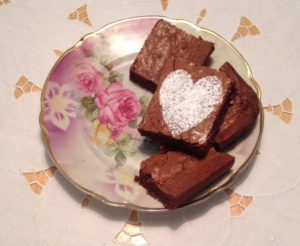
Welcome Brownies – Or – How to bridge story lines.
This is the first entry in my blog series that combines chocolate and the craft of writing. The first topic is how to bridge story lines.
As I celebrate the release of the third book in the Matchmaker Café series, Falling in Love with Emma, about a French baker who wonders if she will ever get out of the friend-zone with the man who owns a fish market, it seemed appropriate to write a food-themed blog that combines chocolate and the craft of writing. Chocolate because it’s mentioned in every book I write, and the craft of writing because I teach writing and am always pushing myself to improve. I also wanted this blog to be about writing tips, so what better place than to talk about the “Welcome Brownies,” and what they mean.
As the story opens, we see both of our characters in their element. Bjorn has just returned from fishing in Alaska, and Emma is up at dawn, baking for a big event in the town where they live. But they are in the friend-zone, with no hope of breaking out of the rut. I also have two story lines. The first involves Emma and Bjorn, and the second is the reocurring story about three sisters from Scotland who own a matchmaking business. The trick was how to get these two stories together.
I needed to create a bridge between story lines. After an event with Emma’s grandmother that left Emma in charge of the bakery, I opened my cookbook and found the perfect recipe I could use to create the bridge. The recipe page was frayed at the edges, torn and scotched taped together. It was a recipe for brownies and was my family’s favorite. It brought back a wave of warm memories. I’d bake these brownies for all occasions, including when new neighbors arrived in our neighborhood, or to bring to a friend. It was the perfect solution. Emma’s grandmother, and one of the story’s mentors, tells Emma to bring over a batch of “Welcome Brownies” to the Retail Village’s newest tenants, the three sisters, who own The Matchmaker Café. Welcome Brownies was the perfect solution. Naturally, the sisters invited Emma inside…and the story takes off…
Please check out book three in the Matchmaker Café series, Falling in Love with Emma and let me know what you think. I have posted the recipe for Welcome Brownies below.
2 sq. unsweetened chocolate (2 oz)
1/4 cup butter
1 cup sugar
2 eggs
3/4 cup flour
1/2 tsp. baking powder
1/2 tsp. salt (I use 1/4 tsp. salt)
Heat oven to 350 degrees. Grease a square pan 8x8x2″. Melt chocolate and butter over hot water. (It says this in the recipe, but I never have. I melt in a saucepan and just watch over it). Take the pan off the stove and beat in the sugar and eggs. Blend flour, baking powder and stir in. Spread in pan. Bake 30 to 35 minutes or until slight imprint remains when touched lightly with finger. Cool slightly and cut into squares. Makes 16 2″ squares.
October 26, 2017
Chocolate and the Craft of Writing – Brownies and Bridge Scenes
Welcome Brownies – Or – How to bridge story lines.
This is the first entry in my blog series that combines chocolate and the craft of writing. The first topic is how to bridge story lines.
As I celebrate the release of the third book in the Matchmaker Café series, Falling in Love with Emma, about a French baker who wonders if she will ever get out of the friend-zone with the man who owns a fish market, it seemed appropriate to write a food-themed blog that combines chocolate and the craft of writing. Chocolate because it’s mentioned in every book I write, and the craft of writing because I teach writing and am always pushing myself to improve. I also wanted this blog to be about writing tips, so what better place than to talk about the “Welcome Brownies,” and what they mean.
As the story opens, we see both of our characters in their element. Bjorn has just returned from fishing in Alaska, and Emma is up at dawn, baking for a big event in the town where they live. But they are in the friend-zone, with no hope of breaking out of the rut. I also have two story lines. The first involves Emma and Bjorn, and the second is the reocurring story about three sisters from Scotland who own a matchmaking business. The trick was how to get these two stories together.
I needed to create a bridge between story lines. After an event with Emma’s grandmother that left Emma in charge of the bakery, I opened my cookbook and found the perfect recipe I could use to create the bridge. The recipe page was frayed at the edges, torn and scotched taped together. It was a recipe for brownies and was my family’s favorite. It brought back a wave of warm memories. I’d bake these brownies for all occasions, including when new neighbors arrived in our neighborhood, or to bring to a friend. It was the perfect solution. Emma’s grandmother, and one of the story’s mentors, tells Emma to bring over a batch of “Welcome Brownies” to the Retail Village’s newest tenants, the three sisters, who own The Matchmaker Café. Welcome Brownies was the perfect solution. Naturally, the sisters invited Emma inside…and the story takes off…
Please check out book three in the Matchmaker Café series, Falling in Love with Emma and let me know what you think. I have posted the recipe for Welcome Brownies below.
2 sq. unsweetened chocolate (2 oz)
1/4 cup butter
1 cup sugar
2 eggs
3/4 cup flour
1/2 tsp. baking powder
1/2 tsp. salt (I use 1/4 tsp. salt)
Heat oven to 350 degrees. Grease a square pan 8x8x2″. Melt chocolate and butter over hot water. (It says this in the recipe, but I never have. I melt in a saucepan and just watch over it). Take the pan off the stove and beat in the sugar and eggs. Blend flour, baking powder and stir in. Spread in pan. Bake 30 to 35 minutes or until slight imprint remains when touched lightly with finger. Cool slightly and cut into squares. Makes 16 2″ squares.
October 23, 2017
Drinking Chocolate – Setting and Symbols

When I first started writing, Falling in Love with Emma, I’m sure it was a “dark and stormy night,” because I thought about the French-style of drinking chocolate…a lot. Spoiler alert. It’s a typical fall day in Seattle, and I’ve just brewed a warm cup of drinking chocolate. Yum! Anyway, back to the blog. In my story, I transported Emma and Bjorn back in time to 18th century Paris, on the eve of the French Revolution, where chocolate houses were almost as abundant as coffee café in Seattle today. For those who have read my books, they know that somewhere in the story, someone will mention their love of chocolate. But Falling in Love with Emma took on a whole new level. Although I knew the time and place, I wanted my readers to feel the atmosphere, or setting, as much as I did. The setting needed to be as important as the characters. After all, the setting would affect how the characters would react. Setting can enhance a character’s mood, or bring them down. Setting can help a character achieve their goal, or stand in the way.
This idea of setting as a character is never more apparent than in a disaster movie, involving fire, wind, or rain. There is a movie, Backdraft, with fire fighter, Kurt Russell, where he and his brother refer to fire as though it were a living, breathing, entity, unpredictable and capable of seeking revenge. This makes fighting fires feel even more dangerous. On the lighter side, the movie Chocolate, with Johnny Depp, not only makes the symbol of chocolate a main character, but this confection, changes in appearance and brings people together. Check out this movie and see for yourself, noting the changes.
When you write describe a setting or add symbols to your novel, you must always ask this question. How does it move the story forward? If you describe the wind or rain, it can’t be just because it sounds cool, there has to be a reason why it’s raining. How does your character respond to rain? Will her response help or hinder her as she tries to move forward? The same can be said for symbols. In Falling in Love with Emma, I have a scene where Emma and Bjorn are eating chocolate fondue. Yes, it can be a sensual dessert, with opportunities to feed each other strawberries dipped in chocolate. But that was not the reason I chose this dessert. Both Emma and Bjorn were on life’s treadmill. They were both in the friend-zone, without knowing how to escape. Bjorn, an Alaskan fisherman, was the type of person who grabbed food when he was hungry. He didn’t taste it, or to expand this idea, he didn’t taste life. Emma was an amazing baker, capable of creating swoon-worthy desserts, and yet, she never took the time to appreciate her talent. Fondue was the perfect choice for this couple. Fondue takes time.
please check out book three in the Matchmaker Café series, Falling in Love with Emma and let me know what you think.



